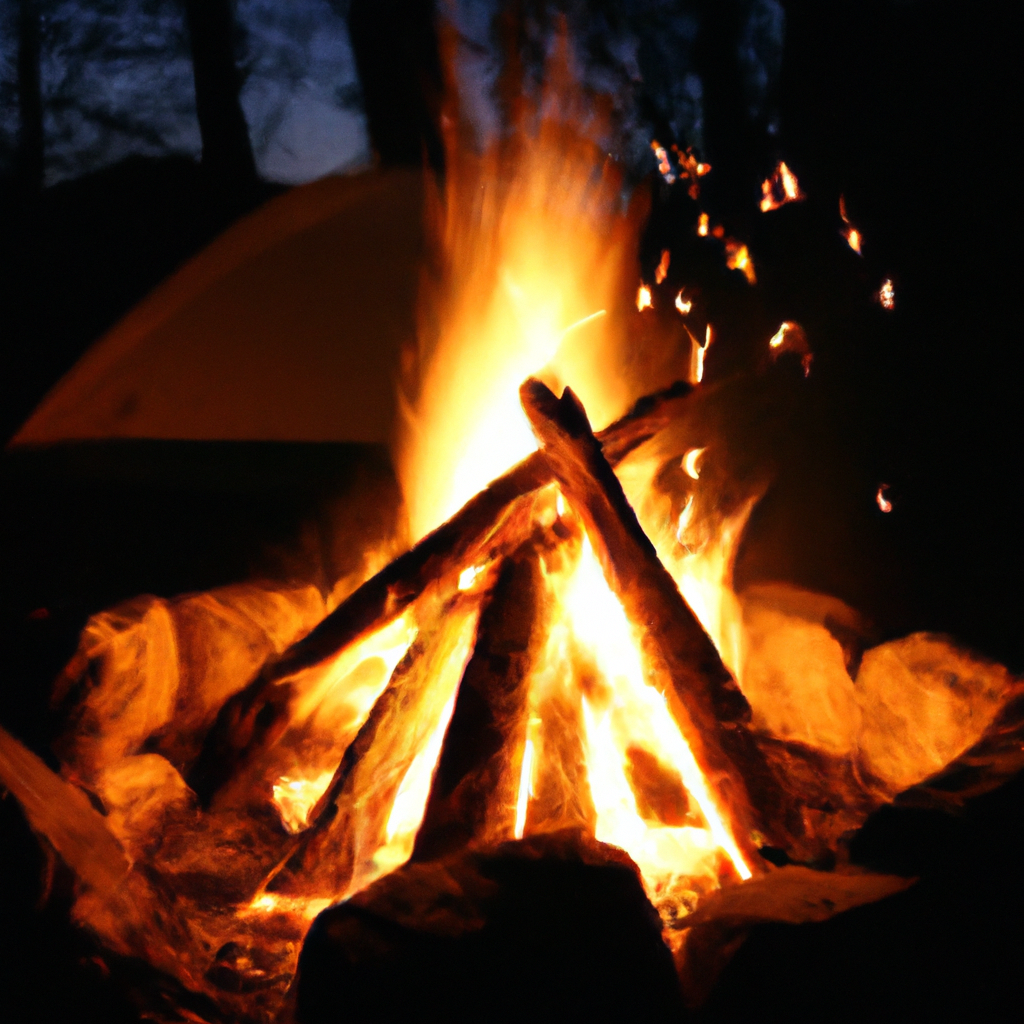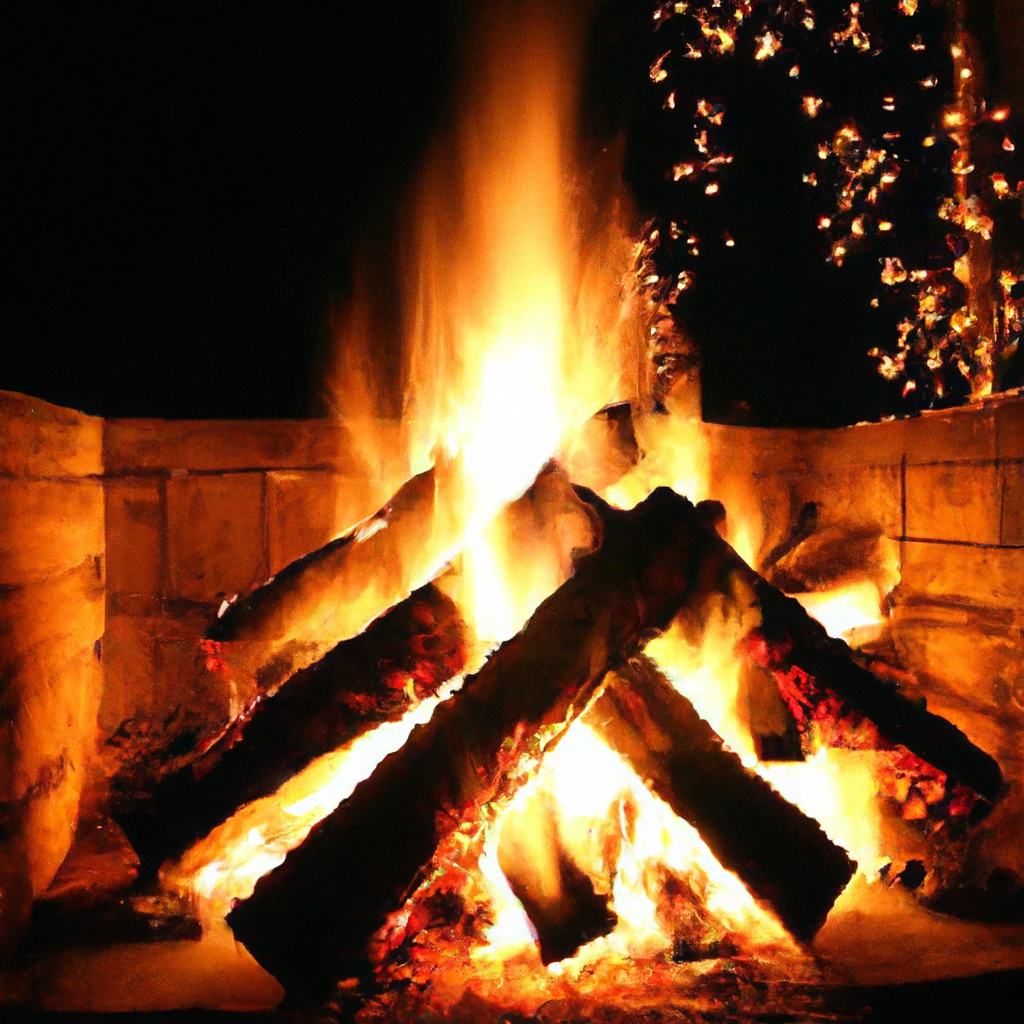Imagine yourself in the middle of a cold night, surrounded by nature’s beauty, camping under a starlit sky. While the experience sounds magical, the chilly temperatures can quickly turn it into a freezing ordeal. So, how can you stay warm during those bone-chilling nights? In this article, we will explore a few simple yet effective tips to keep you cozy and comfortable during your cold night of camping. By following these strategies, you’ll be able to fully embrace the joy of camping while staying warm and snug throughout the night.

Clothing
Layering
When it comes to staying warm during a cold night of camping, layering is key. Layering your clothing allows you to adjust your body temperature by adding or removing layers as needed. Start with a base layer made of moisture-wicking material to keep sweat away from your body. Next, add a middle layer of insulating material, such as fleece or down, to trap heat and provide extra warmth. Finally, top it off with an outer layer that is windproof and waterproof to protect you from the elements.
Wool and Synthetic Materials
Choosing the right materials for your clothing is essential for staying warm. Wool and synthetic materials are excellent choices as they provide insulation even when wet. Wool is a natural fiber that is breathable and helps regulate body temperature. Synthetic materials, such as polyester or nylon, are lightweight, quick-drying, and retain heat even when damp. Consider investing in wool or synthetic socks, pants, and jackets to maximize warmth and comfort.
Hat and Gloves
It’s surprising how much heat can be lost through your head and hands. Wearing a hat and gloves is crucial for keeping warm during a cold night of camping. Look for a hat that covers your ears and is made of a material that insulates well, such as fleece or wool. Opt for gloves that are insulated and waterproof to protect your hands from the cold and wet conditions. Don’t forget to pack an extra pair of gloves in case one gets wet or misplaced.
Thermal Underwear
Thermal underwear, also known as long underwear or base layers, is a must-have for staying warm during chilly nights. Choose a set of thermal underwear made from moisture-wicking material to keep sweat away from your body and provide insulation. Thermal underwear comes in different thicknesses, so consider the temperature and your comfort level when selecting the appropriate thickness. Wearing thermal underwear as your base layer will significantly increase your overall warmth and comfort.
Sleeping Gear
Choosing the Right Sleeping Bag
A good sleeping bag is essential for a warm and comfortable night’s sleep while camping. When selecting a sleeping bag, consider the temperature rating, insulation type, and size. Look for a sleeping bag with a temperature rating that suits the coldest temperature you expect to encounter. Insulation options include down, synthetic, or a combination of both. Down is lightweight and provides excellent insulation, but it loses its insulating properties when wet. Synthetic insulation is more water-resistant and still provides some warmth, even when damp.
Sleeping Pad or Mat
A sleeping pad or mat is crucial for insulating you from the cold ground and providing cushioning for a good night’s sleep. Look for a sleeping pad or mat with good insulation properties to prevent cold from seeping through. Inflatable sleeping pads are lightweight and comfortable, but foam pads offer better insulation. Consider the terrain and your personal preferences when choosing the right sleeping pad or mat for your camping needs.
Sleeping Bag Liner
Using a sleeping bag liner can significantly increase the warmth of your sleeping bag. A liner adds an extra layer of insulation and helps trap your body heat inside the bag. Liners also keep your sleeping bag clean and can be easily washed, ensuring a fresh and hygienic sleeping environment. Look for a liner made of a material that is soft, breathable, and moisture-wicking to maximize comfort and warmth.
Hot Water Bottle
A hot water bottle is a simple and effective way to keep warm throughout the night. Fill a durable, leak-proof bottle with hot water before bed and place it in your sleeping bag. The bottle will release heat slowly, providing warmth for hours. Be sure to secure the bottle tightly to prevent any leaks, and always use a cover or wrap it in a towel to protect your skin from direct contact with the hot surface.
Shelter
Tent Selection
Choosing the right tent is crucial for staying warm and protected during a cold night of camping. Look for a tent that is made of durable and waterproof materials. Consider the size and capacity of the tent to ensure there is enough room for you and your gear. A tent with a rainfly is essential to keep you dry during rain or snowfall. Additionally, look for a tent with good ventilation to reduce condensation buildup and improve air circulation.
Insulating the Tent
To further insulate your tent, there are a few simple steps you can take. First, use a tent footprint or tarp beneath your tent to provide an additional layer of insulation between you and the cold ground. This will help prevent heat loss through conduction. Next, cover any vents or openings in your tent with clothing or extra fabric to prevent cold air from entering and warm air from escaping. Finally, consider placing a tarp over your tent to provide an extra barrier against wind and cold temperatures.
Choosing a Campsite
Selecting the right campsite can make a big difference in how warm and comfortable you are during your camping trip. Look for a location that is sheltered from strong winds and cold drafts. Avoid setting up camp near bodies of water or low-lying areas, as cold air tends to settle in these areas. Instead, choose a spot that is elevated and receives ample sunlight throughout the day. Taking the time to find the ideal campsite will greatly enhance your overall camping experience.

Fire and Heat Sources
Building a Proper Campfire
A campfire is not only a great source of warmth but also a gathering place for campers. Building a proper campfire is essential for staying warm during a cold night of camping. Start by selecting a safe location for your campfire, away from any combustible materials. Use dry, seasoned firewood and kindling to ensure a long-lasting and efficient fire. Remember to follow all fire safety rules and regulations, and never leave a fire unattended.
Using a Portable Heater
If building a campfire is not possible or allowed, using a portable heater is a viable alternative. There are several types of portable heaters available, including propane heaters and electric heaters. When using a portable heater, always follow the manufacturer’s instructions and safety guidelines. Place the heater in a well-ventilated area and keep flammable materials at a safe distance. Portable heaters can provide a consistent source of heat and keep you warm throughout the night.
Hot Water for Warmth
Having hot water on hand can be a game-changer when it comes to staying warm during a cold night of camping. Boil water before bedtime and pour it into a thermos or insulated container. Use this hot water to make warm drinks or fill a hot water bottle to place inside your sleeping bag. Additionally, you can use the hot water to quickly warm up your hands or feet if they get cold. Hot water can provide instant comfort and warmth in chilly camping conditions.
Insulate the Tent
Use a Tent Footprint
A tent footprint, or groundsheet, is a piece of durable fabric that goes beneath your tent to protect it from the ground and provide an extra layer of insulation. Using a tent footprint helps prevent heat loss through conduction and provides added protection against moisture and debris. It also helps extend the lifespan of your tent by reducing wear and tear. Invest in a high-quality tent footprint that matches the size and shape of your tent for optimal insulation.
Cover Vents with Clothing
Most tents come equipped with vents to help circulate air and reduce condensation. However, during cold nights, these vents can let in cold air and decrease the tent’s overall warmth. Combat this by covering the vents with extra clothing or fabric to prevent heat loss. Be sure not to completely block the vents, as some airflow is still necessary for proper ventilation. By insulating the vents, you can reduce cold drafts and maintain a cozy environment inside your tent.
Place a Tarp over the Tent
Another way to provide extra insulation to your tent is by placing a tarp over it. This helps create a barrier against wind, rain, and cold temperatures. Ensure that the tarp is slightly larger than your tent to completely cover it and extend past the sides. Secure the tarp tightly using ropes or bungee cords, making sure it is taut to prevent any sagging. By adding this extra layer of protection, you can significantly increase the warmth and comfort inside your tent.
Stay Dry
Wear Waterproof Outer Layers
One of the main challenges of staying warm during a cold night of camping is staying dry. Wear waterproof outer layers, such as a waterproof jacket and pants, to protect yourself from rain, snow, and moisture. Look for materials that are breathable yet waterproof to prevent sweat from building up inside your clothing. Additionally, invest in waterproof footwear to keep your feet dry and warm, as wet feet can quickly lead to discomfort and heat loss.
Proper Rain Gear
In addition to wearing waterproof outer layers, it’s essential to have proper rain gear readily available. Pack a lightweight and compact rain jacket and pants that can be easily carried in your backpack. During unexpected rain or snowfall, quickly putting on your rain gear will keep you dry and prevent moisture from seeping into your clothing layers. Staying dry is crucial for maintaining body heat and avoiding unnecessary discomfort in cold camping conditions.
Protect Your Sleeping Bag
Your sleeping bag is your haven during a cold night of camping, so it’s crucial to keep it dry at all costs. Before setting up your tent, inspect the ground for any signs of water pooling or potential leaks. Choose a flat and elevated spot to minimize the risk of water trickling into your tent. Additionally, make sure your tent is properly sealed to prevent any moisture from entering. Inside your tent, keep your sleeping bag elevated from the ground by using a sleeping pad or mat to further protect it from any damp conditions.
Warm Drinks and Food
Hot Drinks
Warm drinks are not only comforting but can also help raise your body temperature from the inside out. Pack a thermos or insulated bottle with your favorite hot beverage, such as tea, coffee, or hot chocolate. Sipping on a warm drink throughout the night will provide a soothing and warming effect. Avoid caffeine or excessive sugar, as they can disrupt your sleep. Opt for herbal teas or decaffeinated beverages for a cozy and relaxing camping experience.
Warm, High-Calorie Meals
Eating warm, high-calorie meals before bed can help fuel your body and keep you warm throughout the night. Choose meals that are easy to prepare and require minimal cooking time. Foods that are high in protein and healthy fats, such as nuts, dried fruits, and trail mix, provide a sustained source of energy and help keep your body warm. Additionally, consider packing warm soup or canned meals that can be easily heated on a portable stove or campfire.
Insulated Containers
To ensure that your hot drinks and meals stay warm for extended periods, invest in insulated containers. Thermoses or insulated food jars are designed to keep liquids and food hot for several hours. Opt for containers with a wide mouth for easy pouring and serving. Before bed, fill your insulated container with hot water and place it inside your tent. This not only keeps your drinks and food warm but also acts as a source of additional heat in your tent.
Keep Active
Exercise and Movement
Staying active is an excellent way to generate body heat and keep warm during a cold night of camping. Engage in activities that get your blood flowing, such as jumping jacks, jogging in place, or dancing. These movements increase your heart rate and circulation, which in turn generates heat throughout your body. Take short breaks from being sedentary and make it a point to incorporate movement into your camping routine.
Stretching and Yoga
Stretching and yoga are not only beneficial for flexibility and relaxation but can also help keep you warm. Perform gentle stretches and yoga poses that target the major muscle groups in your body. These movements increase blood flow and warm up your muscles, providing a comfortable and cozy feeling. Additionally, yoga and stretching can help improve overall sleep quality, making for a more restful night under the stars.
Take Short Walks
If possible, take short walks around your camping area to get your blood circulating and generate heat. Walking helps increase your body’s warmth by increasing metabolic rate and encouraging circulation. Explore the surroundings of your campsite, admire the beauty of nature, and let the physical activity boost your body temperature. Just be sure not to overexert yourself, and always stay hydrated during your walks.
Additional Tips
Use Hand and Foot Warmers
Hand and foot warmers are small packets that generate heat when exposed to air. They are a convenient and portable way to keep your extremities warm during a cold night of camping. Activate the warmers by shaking them or following the manufacturer’s instructions, and then place them inside your gloves or shoes. The heat generated can last for several hours, providing warmth and comfort to your hands and feet.
Stay Hydrated
Staying hydrated is important for overall health and well-being, even during cold nights of camping. Dehydration can impair your body’s ability to regulate temperature and can lead to increased heat loss. Drink plenty of fluids throughout the day, including water and warm beverages, to stay hydrated. Consider using an insulated water bottle to prevent liquids from freezing and to have a readily available source of hydration throughout the night.
Avoid Excessive Alcohol Consumption
While it may be tempting to indulge in a few alcoholic beverages to warm up, it’s important to avoid excessive alcohol consumption during cold nights of camping. Alcohol may make you feel temporarily warm, but it actually causes blood vessels to dilate, resulting in increased heat loss from your body. Additionally, alcohol can impair judgment and coordination, making you more susceptible to hypothermia or other cold-related injuries. Moderation is key to staying warm and safe during your camping adventure.
Share Body Heat
When camping with a partner or a group, sharing body heat is an effective way to stay warm. Cuddle up inside your sleeping bags or huddle close together while sitting around the campfire. Close proximity allows for body heat to be shared, keeping everyone more insulated and comfortable. Use sleeping bags that have compatible zippers, allowing you to zip them together for better comfort and warmth.
Emergency Preparedness
Emergency Blankets
Emergency blankets, also known as space blankets, are lightweight and compact thermal blankets designed to retain and reflect body heat. They are an essential item to have in your camping pack for added protection against cold temperatures. In case of emergencies or extreme cold, wrap yourself in an emergency blanket to conserve heat and prevent hypothermia. Emergency blankets are inexpensive and take up minimal space, making them an invaluable tool for cold-weather camping.
Signal for Help
In the event of an emergency or if you find yourself in need of assistance, it’s important to have a way to signal for help. Three common ways to do this are using a whistle, mirrors, or a flashlight. These items are lightweight and easy to carry in your backpack. Learn the proper techniques for using these signaling devices and ensure they are easily accessible in case of an emergency.
Avoid Hypothermia
Hypothermia is a potentially life-threatening condition that occurs when your body loses heat faster than it can produce heat, resulting in a dangerously low body temperature. To avoid hypothermia, it’s crucial to be prepared and take preventive measures. Dress appropriately in layers, stay dry, and insulate your sleeping gear and shelter properly. Monitor yourself and your camping companions for signs of hypothermia, such as shivering, confusion, or slurred speech. If symptoms occur, take immediate action to warm up and seek medical assistance if necessary.
By following these comprehensive tips and guidelines, you can stay warm and comfortable during a cold night of camping. Remember to dress in layers, insulate your sleeping gear and shelter, stay dry, and keep your body active. With the right preparation and mindset, you can fully enjoy the beauty and serenity of nature while camping in colder temperatures. Stay warm and happy camping!

